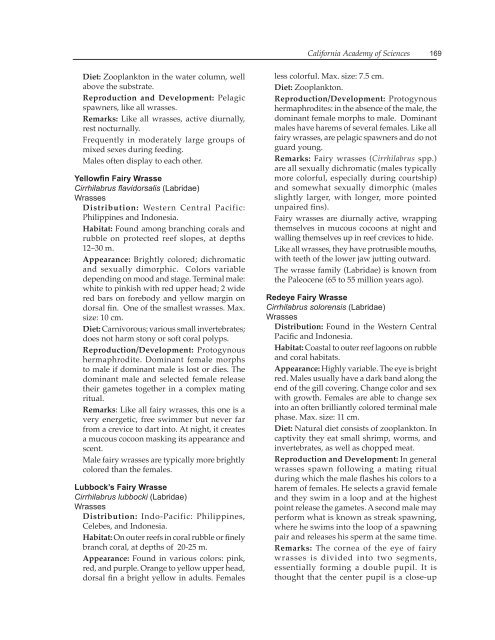THE STEINHART AQUARIUM - Gulf of Guinea Science ...
THE STEINHART AQUARIUM - Gulf of Guinea Science ...
THE STEINHART AQUARIUM - Gulf of Guinea Science ...
You also want an ePaper? Increase the reach of your titles
YUMPU automatically turns print PDFs into web optimized ePapers that Google loves.
Diet: Zooplankton in the water column, well<br />
above the substrate.<br />
Reproduction and Development: Pelagic<br />
spawners, like all wrasses.<br />
Remarks: Like all wrasses, active diurnally,<br />
rest nocturnally.<br />
Frequently in moderately large groups <strong>of</strong><br />
mixed sexes during feeding.<br />
Males <strong>of</strong>ten display to each other.<br />
Yellowfin Fairy Wrasse<br />
Cirrhilabrus flavidorsalis (Labridae)<br />
Wrasses<br />
Distribution: Western Central Pacific:<br />
Philippines and Indonesia.<br />
Habitat: Found among branching corals and<br />
rubble on protected reef slopes, at depths<br />
12–30 m.<br />
Appearance: Brightly colored; dichromatic<br />
and sexually dimorphic. Colors variable<br />
depending on mood and stage. Terminal male:<br />
white to pinkish with red upper head; 2 wide<br />
red bars on forebody and yellow margin on<br />
dorsal fin. One <strong>of</strong> the smallest wrasses. Max.<br />
size: 10 cm.<br />
Diet: Carnivorous; various small invertebrates;<br />
does not harm stony or s<strong>of</strong>t coral polyps.<br />
Reproduction/Development: Protogynous<br />
hermaphrodite. Dominant female morphs<br />
to male if dominant male is lost or dies. The<br />
dominant male and selected female release<br />
their gametes together in a complex mating<br />
ritual.<br />
Remarks: Like all fairy wrasses, this one is a<br />
very energetic, free swimmer but never far<br />
from a crevice to dart into. At night, it creates<br />
a mucous cocoon masking its appearance and<br />
scent.<br />
Male fairy wrasses are typically more brightly<br />
colored than the females.<br />
Lubbock’s Fairy Wrasse<br />
Cirrhilabrus lubbocki (Labridae)<br />
Wrasses<br />
Distribution: Indo-Pacific: Philippines,<br />
Celebes, and Indonesia.<br />
Habitat: On outer reefs in coral rubble or finely<br />
branch coral, at depths <strong>of</strong> 20-25 m.<br />
Appearance: Found in various colors: pink,<br />
red, and purple. Orange to yellow upper head,<br />
dorsal fin a bright yellow in adults. Females<br />
California Academy <strong>of</strong> <strong>Science</strong>s<br />
169<br />
less colorful. Max. size: 7.5 cm.<br />
Diet: Zooplankton.<br />
Reproduction/Development: Protogynous<br />
hermaphrodites: in the absence <strong>of</strong> the male, the<br />
dominant female morphs to male. Dominant<br />
males have harems <strong>of</strong> several females. Like all<br />
fairy wrasses, are pelagic spawners and do not<br />
guard young.<br />
Remarks: Fairy wrasses (Cirrhilabrus spp.)<br />
are all sexually dichromatic (males typically<br />
more colorful, especially during courtship)<br />
and somewhat sexually dimorphic (males<br />
slightly larger, with longer, more pointed<br />
unpaired fins).<br />
Fairy wrasses are diurnally active, wrapping<br />
themselves in mucous cocoons at night and<br />
walling themselves up in reef crevices to hide.<br />
Like all wrasses, they have protrusible mouths,<br />
with teeth <strong>of</strong> the lower jaw jutting outward.<br />
The wrasse family (Labridae) is known from<br />
the Paleocene (65 to 55 million years ago).<br />
Redeye Fairy Wrasse<br />
Cirrhilabrus solorensis (Labridae)<br />
Wrasses<br />
Distribution: Found in the Western Central<br />
Pacific and Indonesia.<br />
Habitat: Coastal to outer reef lagoons on rubble<br />
and coral habitats.<br />
Appearance: Highly variable. The eye is bright<br />
red. Males usually have a dark band along the<br />
end <strong>of</strong> the gill covering. Change color and sex<br />
with growth. Females are able to change sex<br />
into an <strong>of</strong>ten brilliantly colored terminal male<br />
phase. Max. size: 11 cm.<br />
Diet: Natural diet consists <strong>of</strong> zooplankton. In<br />
captivity they eat small shrimp, worms, and<br />
invertebrates, as well as chopped meat.<br />
Reproduction and Development: In general<br />
wrasses spawn following a mating ritual<br />
during which the male flashes his colors to a<br />
harem <strong>of</strong> females. He selects a gravid female<br />
and they swim in a loop and at the highest<br />
point release the gametes. A second male may<br />
perform what is known as streak spawning,<br />
where he swims into the loop <strong>of</strong> a spawning<br />
pair and releases his sperm at the same time.<br />
Remarks: The cornea <strong>of</strong> the eye <strong>of</strong> fairy<br />
wrasses is divided into two segments,<br />
essentially forming a double pupil. It is<br />
thought that the center pupil is a close-up


